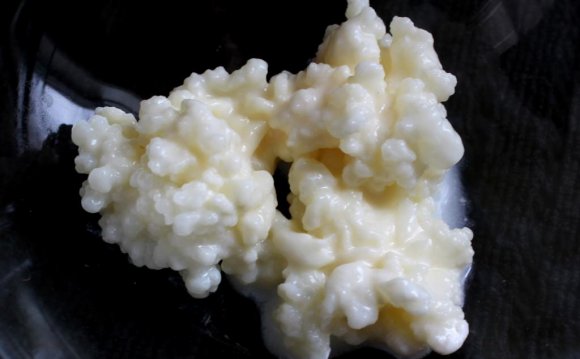

What Are Kefir Grains?
Kefir grains are small living communities of bacteria, yeast, and kefiran, existing in solid, gummy, grain-like masses that multiply when properly cared for.
Kefiran is an exopolysaccharide (EPS) matrix produced by the lactic acid bacteria. Think of it as the house in which bacteria and yeast live.
- When you feed kefir grains, or use them for fermentation, the bacteria and yeast multiply.
- The families of microorganisms grow, and they need bigger homes or new homes altogether.
- Growing numbers of microorganisms lead to bacteria producing more of this building material called kefiran.
- This is what leads kefir grains themselves, housing and all, to grow.
Traditionally, kefir grains have been used to ferment grass-fed, unpasteurized diary. During the fermentation process, milk sugars were consumed, and the result was a sour beverage teeming with beneficial microorganisms.
- Before drinking kefir, the kefir grains are separated from the kefir beverage.
- These grains are reserved for later use.
- When properly cared for, kefir grains last a very long time and multiply in numbers.
- The polysaccharide matrix (EPS) helps to thicken the texture of kefir.
- Certain bacteria are responsible for building the matrix that creates the grains themselves.
Fermented foods are one of the oldest secrets to robust health!
This is why fermented foods have such a long history in cultures across the globe. Many people believe that good health begins in the gut. After all, food is what nourishes us on a day-to-day basis. If we are unable to properly digest food and absorb its nutrients, a series of health issues can arise.
Fermented foods, like kefir, yogurt, sauerkraut, and kimchee, have multiple health benefits:
- Break down foods, helping with the digestive process.
- Are enzyme-rich, also ensuring smooth digestion.
- Carry beneficial microbes into the gut that live symbiotically with the cells in the intestinal tract.
- Contribute to the beneficial microbial community in the gut and build a protective biofilm along the intestinal wall.
- Communicate with the body’s immune system and cool down inflammation.
- Promote the production of key vitamins that gut bacteria are especially good at synthesizing.
- Nourish a healthy, alkaline inner ecosystem.
Your diet determines what kinds of microbes live in your gut.
No matter what you eat, your entire body is populated with billions of microorganisms. The food that you eat creates the environment for these microorganisms to live.
Microbes living in a community will build a biofilm around themselves. A biofilm is like the kefiran of kefir grains. It is a housing matrix. And it protects the organisms living within it.
- Good bacteria build a protective, nourishing biofilm that works synergistically with our intestinal cells.
- Pathogenic organisms build gluey slime that inhibits healthy digestion.
- Good bacteria can break down pathogenic biofilm.
Consider a densely populated city and a patch of forested land, and it is easy to see the effects of environment.
- While both environments have life, there is a greater sense of balance in a forested land because of the various plant life, animals, insects, and the rich soil.
- Urban landscapes are generally more homogenized and congested.
Because diversity has been reduced and little attention is put toward replenishing the native balance of the land, you will see an environment overrun by virulent pests. Think of rodents and pigeons. They are hardy themselves and tend to carry their own pathogens.
This is like a body overrun by Candida or another systemic infection. At this stage, it is necessary to heal the inner ecosystem with specific microorganisms that have a proven, beneficial effect on the body.
The diversity and numbers of microbes in kefir grains are still too numerous to count!
That’s right. Researchers are still learning about the microbial population in kefir grains. (1) While kefir grains are a rich source of bacteria and yeast, we still have not identified all the microorganisms present in kefir grains. Grains can also house different communities, depending on their environment.
Problems with Traditional Kefir Grains
- This community changes based on the environment that the grains are in.
- Grains can become contaminated with frequent, or even infrequent, use.
- You cannot be certain that your kefir grains contain the correct microflora that will heal the intestinal lining.
- This becomes especially important to those with a permeable gut or a permeable blood brain barrier.
Oftentimes, inflammation is systemic, and a permeable intestinal lining goes hand-in-hand with a permeable blood brain barrier. This is frequently referred to as leaky gut and leaky brain. A permeable gut means that undigested food particles and opportunistic microbes can get into the bloodstream. Once this happens, the immune system gets activated and can result or contribute to a number of disorders, such as autoimmunity, allergies, and food sensitivities.
- The gut, or enteric nervous system, is full of neurons and neurotrasmitters.
- The gut and the brain are uniquely connected. This is called the gut-brain axis.
- Safety
- Control
- Specific, targeted function
Body Ecology has retained all the benefits of kefir while also delivering specific microorganisms that are known to benefit digestive health.
Some of these strains, such as Lactobacillus kefyr, are included in the Body Ecology Kefir Starter culture.
The Body Ecology Kefir Starter culture can be used to ferment dairy.
- We recommend raw, 100% grass-fed cow or goat dairy.
- A grass-fed diet creates the most nutrient-dense milk.
- Be sure and purchase only organic young Thai coconuts.
- Non-organic coconuts are heavily treated with chemicals like fungicide and formaldehyde so that they survive shipment and long-term storage.
- Non-organic coconuts have the white, cone-shaped husk. This husk would not remain white if it was left untreated.
YOU MIGHT ALSO LIKE




 Saturated fat is fat that consists of triglycerides containing only saturated fatty acids. Saturated fatty acids have no double bonds between the individual carbon atoms of the fatty acid chain. That is, the chain of carbon atoms is fully "saturated" with hydrogen...
Saturated fat is fat that consists of triglycerides containing only saturated fatty acids. Saturated fatty acids have no double bonds between the individual carbon atoms of the fatty acid chain. That is, the chain of carbon atoms is fully "saturated" with hydrogen...








